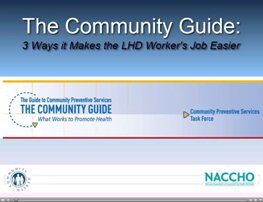
Step 1
CONSULT YOUR CHA/CHIP

Step 2
WRITE A PROBLEM STATEMENT

Step 3
WRITE SMART GOALS AND OBJECTIVES

Step 4
REVIEW AND SELECT STRATEGIES

Step 5
PLAN TO ADAPT AND IMPLEMENT THE STRATEGY

Step 6
IMPLEMENT AND EVALUATE THE STRATEGY
LEARN HOW THE COMMUNITY GUIDE CAN MAKE THE LHD WORKER’S JOB EASIER
View NACCHO’s Screencast Series
THE
COMMUNITY
GUIDE &
THE RESOURCE
CENTER
This site is part of a suite of resources that belong to NACCHO's Resource Center for Evidence-Based Prevention and Cross Sector Approaches.

Click to visit the
Resource Center
Step 3:
Write SMART Goals and Objectives
Drafting measurable goals and objectives for your prevention efforts is a good way to quantify progress toward addressing the health priorities in your jurisdiction. Goals and objectives help shape the focus of your prevention efforts, desired results, and how they will be achieved, thereby making it easier to select appropriate evidence-based strategies from The Community Guide. NACCHO recommends LHDs use the SMART technique for writing objectives to best help them monitor progress and set targets. SMART objectives are:
- Specific-identifying what change will take place, the target audience, and location of the intervention.
- Measurable-identifying the amount of change expected.
- Achievable-realistic to implement in relation to available resources.
- Relevant-in direct relation to achieving your goals.
- Time-bound-indicating by when the objective will be completed.
Here is an example of a SMART objective:
Reduce by 10% the percent of non smoking adults aged 18 years and older who are exposed to secondhand smoke in the state of KS.
NACCHO recommends LHDs consult Healthy People 2020 Leading Health Indicators to help set targets for their goals and objectives. To learn how, click here.
Links to Helpful Tools
- CDC Guidance: Writing SMART Objectives
Learn more - Healthy People 2020 Leading Health Indicators
